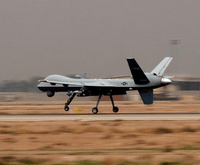The past year has been a pivotal period for one of the world's most important strategic industries. In 2009 and early 2010, the military aerospace industry marked key turning points: For the first time, the U.S. Air Force -- the world's most important aerospace customer -- bought more unmanned aircraft than manned aircraft. In the same time-span, the Air Force refused to extend production of its exclusive, world-beating F-22 fighter beyond the 187 units it has already ordered, instead opting to develop the smaller, potentially cheaper-per-unit and exportable F-35 Joint Strike Fighter.
Following that decision, revelations surfaced in early 2010 indicating that the F-35 faces serious, potentially fatal technical problems. Nevertheless, the Pentagon counts on the F-35 not only to fill out U.S. fighter squadrons, but also to serve as the cornerstone of an unprecedented, global, military and jobs alliance. Indeed, the F-35's potential as a diplomatic and industrial deal-maker far outweighs its importance as a weapon for day-to-day use. For that reason, Washington is scrambling to save the troubled program. Also for that reason, most of the F-35's potential customers on five continents remain committed to the plane.
The F-35 is not unique in this respect. In recent decades, so-called "mega-programs" in which two or more nations team up to develop and build expensive, sophisticated aircraft have dominated the aerospace industry. Other examples include the four-nation Eurofighter Typhoon, the A400M airlifter overseen by a consortium of eight -- mostly European -- countries, and Russia's answer to the F-22, the T-50 fighter, which is slated for further development as a joint Russian-Indian project.

